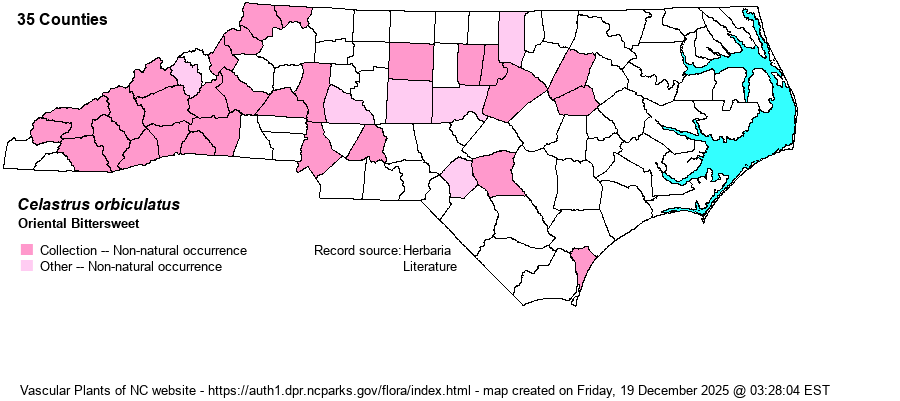| Author | Thunberg | |
| Distribution | Mostly Mountains and upper Piedmont, scattered eastward to New Hanover County. First collected in 1932 by Schiele and Smith at Chimney Rock in Rutherford County (originally determined as C. scandens). In cultivation in NC by the early 1950s (at least), escapes found as early as 1953 (Orange Co.), 1962 (Henderson Co.), 1963 (Buncombe Co.), and 1970 (New Hanover Co.).
Native to China, Japan, Korea; in N.A. -- P.E.I. to Ont., south to GA, AR, KS. | |
| Abundance | Now mostly common to locally abundant in the Mountains, uncommon in the Piedmont (frequent in Orange Co.), rare in the Coastal Plain. Its rapid spread since 1990 or so is cause for much concern, especially in the Mountains, as this is an aggressive plant that can displace native species and weaken adult trees. Most laypersons assume that any bittersweet they see is the native species, but the native species -- C. scandens -- is rather rare and declining in numbers, presumably being impacted by this exotic species. | |
| Habitat | Roadside thickets, disturbed woods, alluvial woods and bottomlands, forest margins, campus woodlots. | |
| Phenology | Flowering May-June; fruiting August-October. | |
| Identification | Oriental Bittersweet is a handsome climbing vine, thus its introduction for ornament. Stems reportedly may reach more than 125 feet (!) and tightly hug tree trunks, though they usually just sprawl over shrubs and saplings along forest margins. Leaves are broadly obovate to sub-orbicular, 1.5-2.5 inches long and mostly rounded or blunt at the end, although some may taper to a blunt tip. Flowers are small and white with recurved petals, 2-3 per axil (male flowers may also grow terminally), never in a terminal branched panicle as does C. scandens. The conspicuous fruits are orange or yellow-orange capsules; these capsules soon split open, exposing the several bright scarlet-red arils ("berries"). The native species has narrower leaves -- mostly elliptical as opposed to rather orbicular, and the flower clusters and thus fruits are present only at the branch tips and not scattered along the branches. | |
| Taxonomic Comments | | |
| Other Common Name(s) | | |
| State Rank | SE | |
| Global Rank | GNR | |
| State Status | | |
| US Status | | |
| USACE-agcp | FACU link |
| USACE-emp | FACU link |

